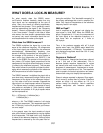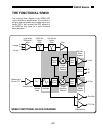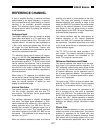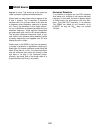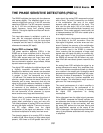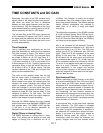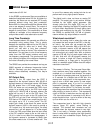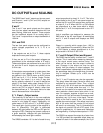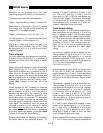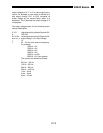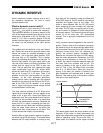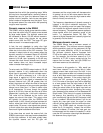
3-11
SR850 Basics
Remember, the output of the PSD contains many
signals. Most of the output signals have frequen-
cies which are either the sum or difference
between an input signal frequency and the refer-
ence frequency. Only the component of the input
signal whose frequency is exactly equal to the ref-
erence frequency will result in a DC output.
The low pass filter at the PSD output removes all
of the unwanted AC signals, both the 2F (sum of
the signal and the reference) and the noise com-
ponents. This filter is what makes the lock-in such
a narrow band detector.
Time Constants
Lock-in amplifiers have traditionally set the low
pass filter bandwidth by setting the time constant.
The time constant is simply 1/2πf where f is the
-3 dB frequency of the filter. The low pass filters
are simple 6 dB/oct roll off, RC type filters. A 1
second time constant referred to a filter whose
-3 dB point occurred at 0.16 Hz and rolled off at
6 dB/oct beyond 0.16 Hz. Typically, there are two
successive filters so that the overall filter can roll
off at either 6 dB or 12 dB per octave. The time
constant referred to the -3 dB point of each filter
alone (not the combined filter).
The notion of time constant arises from the fact
that the actual output is supposed to be a DC
signal. In fact, when there is noise at the input,
there is noise on the output. By increasing the time
constant, the output becomes more steady and
easier to measure reliably. The trade off comes
when real changes in the input signal take many
time constants to be reflected at the output. This is
because a single RC filter requires about 5 time
constants to settle to its final value. The time
constant reflects how slowly the output responds,
and thus the degree of output smoothing.
Note that the SR850 displays the time constant
and the equivalent noise bandwidth (ENBW) in the
time constant menu. The ENBW is NOT the filter
-3 dB pole, it is the effective bandwidth for
Gaussian noise. More about this later.
Digital Filters vs Analog Filters
The SR850 improves on analog filters in many
ways. First, analog lock-ins provide at most, two
stages of filtering with a maximum roll off of
TIME CONSTANTS and DC GAIN
12 dB/oct. This limitation is usually due to space
and expense. Each filter needs to have many dif-
ferent time constant settings. The different settings
require different components and switches to
select them, all of which is costly and space
consuming.
The digital signal processor in the SR850 handles
all of the low pass filtering. Each PSD can be fol-
lowed by up to four filter stages for up to 24 dB/oct
of roll off. Since the filters are digital, the SR850 is
not limited to just two stages of filtering.
Why is the increased roll off desirable? Consider
an example where the reference is at 1 kHz and a
large noise signal is at 1.05 kHz. The PSD noise
outputs are at 50 Hz (difference) and 2.05 kHz
(sum). Clearly the 50 Hz component is the more
difficult to low pass filter. If the noise signal is
80 dB above the full scale signal and we would
like to measure the signal to 1% (-40 dB), then the
50 Hz component needs to be reduced by 120 dB.
To do this in two stages would require a time con-
stant of at least 3 seconds. To accomplish the
same attenuation in four stages only requires
100 ms of time constant. In the second case, the
output will respond 30 times faster and the experi-
ment will take less time.
Synchronous Filters
Another advantage of digital filtering is the ability
to do synchronous filtering. Even if the input signal
has no noise, the PSD output always contains a
component at 2F (sum frequency of signal and ref-
erence) whose amplitude equals or exceeds the
desired DC output depending upon the phase. At
low frequencies, the time constant required to
attenuate the 2F component can be quite long. For
example, at 1 Hz, the 2F output is at 2 Hz and to
attenuate the 2 Hz by 60 dB in two stages requires
a time constant of 3 seconds.
A synchronous filter, on the other hand, operates
totally differently. The PSD output is averaged
over a complete cycle of the reference frequency.
The result is that all components at multiples of
the reference (2F included) are notched out com-
pletely. In the case of a clean signal, almost no
additional filtering would be required. This is
increasingly useful the lower the reference fre-
quency. Imagine what the time constant would



